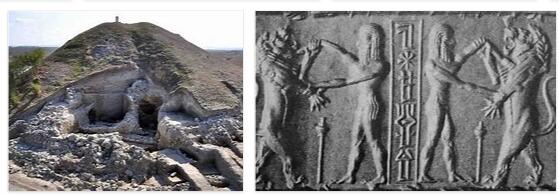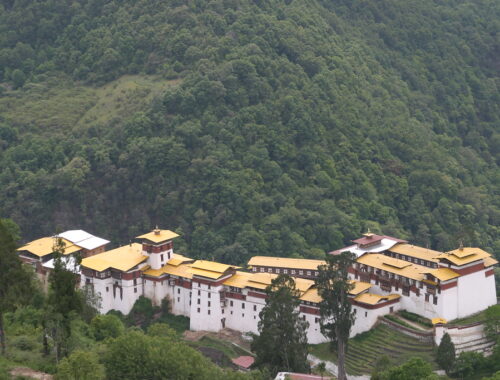
Prehistory of Eastern Europe
Cultures of the Paleolithic, the early Paleolithic (Acheuléen), are only weakly represented in Eastern Europe. Sure finds seem to be limited to the eastern Black Sea region (Caucasus, Prehistory). Finds from the Middle Paleolithic (Micoquien and Moustérien) come from BC. a. from caves and open-air stations, including the Kiik-Koba cave in the Crimea and the Abri Starosselje (near Bakhchisarai) with burials of Neanderthals. Significant for the Upper Paleolithic include: the outdoor stations of Kostjonki, Gagarino (100 km north of Voronezh), Mesin (about 25 km south of Novgorod-Seversky) and Meshirich (about 100 km south-east of Kiev), where remains of submerged dwellings (partly erected using mammoth bones), burials within the storage areas and evidence of the oldest art (female statuettes, animal sculptures and devices with engravings) were found. The Kapowa Cave in the Southern Urals contains impressive rock art, Sungir. In the Mesolithic Age, the Tardenoisia, characterized by microlithic stone tools, was widespread in the Baltic States, in western Russia and in northwestern Ukraine on sand dunes and in river valleys; north of it the Kunda culture, for which devices made of antlers and bones (harpoons, axes, hatchets) have been handed down.
According to Countryaah, influences of the Neolithic (Neolithic) have Eastern Europe in the 6th millennium BC Reached from the Balkans and later via the Caucasus. Evidence of the Bug-Dniester culture, which is related to the Southeast European Starčevo-Körös culture, is the legacy of population groups who lived mainly from hunting and fishing. Small settlements with rectangular houses on stone foundations form the actual villages, while settlements on islands and floodplains could only be visited in times of low water. In addition to the dog, pigs and cattle have been identified as pets. The widespread Dnieper-Donets group is connected with the early phase of the Bug-Dniester culture through pointed-bottom ceramics, on the other hand there are correspondences to the forms of the cultural groups ranging from the Memel to the Aral Sea with comb and dimple ceramics. Band ceramics have expanded to the Dniester in Eastern Europe. It met here with the Bug-Dniester culture, which was eventually replaced in its entire area of distribution by the Cucuteni-Tripolje culture, which forms the most distinctive Neolithic culture in Eastern Europe.
In the 3rd millennium BC Chr. Was the southern steppe of Eastern cultures, especially the ocher grave culture whose support beisetzten their dead under kurgans dominated. The intensive use of horses and carts and the increase in the keeping of sheep and goats in addition to cattle are significant for the economy of steppe cultures. These economic changes are associated with greater mobility of the individual settlement groups. The similarity of the steppe cultures to one another and their rapid expansion have led to many theses in archeology about their origins. Especially in the question of the origin of the Indo-Europeans, the phenomenon has given rise to numerous interpretations. The decisive factor for this was the morphological relationship with the central and northern European battle ax cultures.
In the Neolithic period, northern and central Eastern Europe were particularly populated by the bearers of the comb and pit ceramic cultures, which are ascribed to the Finno-Ugric tribal groups. The hunter cultures connecting the Urals with Scandinavia are divided into five zones. Due to the occurrence of rock art, the zones of the subarctic groups and those of the Kama-Ural group are particularly important in terms of cultural and religious history. While the southern groups of the Neolithic hunter cultures in the middle of the 3rd millennium BC Were replaced by cattle breeding groups (Fatjanowokultur ), the northern groups with little economic and cultural changes continued until the 1st millennium BC. Persisted.
The cultural impulses of Transcaucasia began in the Bronze Age on the Kuban in the 2nd half of the 3rd millennium BC. Led to the Maykop and Novoswobodnajakultur and in the 2nd millennium to the North Caucasian culture, which became the metallurgical centers of Eastern Europe. In western Eastern Europe, which was dependent on the copper deposits in the Carpathian Mountains, the Borodino hoard is evidence of diverse economic connections during the Middle Bronze Age. During this period, the bar grave culture, the Abashevo culture and the western Andronovo culture form distinctive regional groups of the catacomb grave culture, whose bearers were cattle breeders with a nomadic, later also sedentary pasture economy. Copper mining centers were in the Urals. The metal processing of the tribes on the central Volga and in the Kama region led to trade connections that stretched from the Urals to the Baltic Sea. From around 1800 BC There were significant population shifts in the Eurasian steppes, which are associated with the use of light horse-drawn carriages with spoked wheels. The catacomb burial culture ended and was replaced by tribes who produced new types of ceramic forms (bulge ceramic culture) and are considered to be sedentary cattle breeders. The »Thracocimmerian horizon«, a group of finds with metal parts from horse harnesses, offers reliable clues for a pre-Scythian equestrian people. Several Bronze Age cultural groups in Eastern Europe are also considered to be protoskythic, especially the bar grave culture, whose bearers began around 1600 BC. BC, coming from the east, invaded the northern Pontic steppes. Numerous fortified settlements (e.g. Lewenkowka on the lower Don) were destroyed, the bulge pottery could later only be found further west. The barred grave culture was associated with the densest Bronze Age settlement of the steppe areas and an intensification of the use of bronze. From the 12th century BC However, a general economic crisis phase with population decline set in – presumably due to strong climatic fluctuations with periods of drought. In the 9th century BC Settlements were abandoned and a nomadic way of life and economy as cattle herders were taken up again.
Related Posts:

Yemen Culture and Traditions

Nagorno-Karabakh Part I
You May Also Like

Catherine Weitzman Fashion Jewelry
March 3, 2015
Bhutan Travel Guide
November 16, 2020